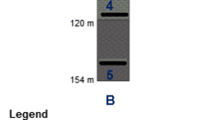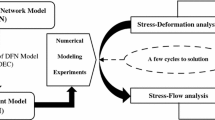Abstract
This study quantifies experimentally the influence of groundwater on the thermal conductivity measurements via thermal response tests (TRT) in a fractured hard rock with low matrix permeability. An artificial groundwater flow towards a nearby well was induced by groundwater extraction and a TRT performed simultaneously. The results were compared with a TRT performed 24 days later in the same well without groundwater extraction. The effect of the groundwater flow is shown indirectly by the enhanced effective thermal conductivity and directly through the comparison of temperature profiles before and 4 h after both TRTs. Simulations in FEFLOW show that a groundwater flow velocity of 130–1,300 m d−1 through one open horizontal fracture of small volume increases the effective thermal conductivity by 11 % in the studied system.
Résumé
Cette étude quantifie expérimentalement l’influence de l’eau souterraine sur les mesures de conductivité thermique via des essais de réponse thermique (TRT) dans un massif rocheux fracturé présentant une faible perméabilité de matrice. Un écoulement artificiel vers un puits proche a été induit par un pompage et un test TRT a été réalisé simultanément. Les résultats ont été comparés avec un autre test TRT réalisé 24 jours plus tard dans le même puits sans pompage. L’effet de l’écoulement est montré indirectement par la modification de la conductivité thermique effective et directement par la comparaison des profils de température pour les deux tests TRT, avant et pendant les quatre heures suivant les tests. Des simulations numériques avec Feflow montrent qu’une vitesse d’écoulement de 130 à 1300 m j−1 au travers d’une fracture horizontale de faible ouverture augmente la conductivité thermique effective de 11 % dans le système étudié.









Similar content being viewed by others
Abbreviations
- BHE:
-
Borehole heat exchanger
- Q :
-
Heat injection rate per meter of borehole length (W m−1)
- R b :
-
Borehole resistance (K W−1 m−1)
- t :
-
Time (s)
- \( \bar{T} \) :
-
Average fluid temperature of the circulation fluid (°C)
- TRT:
-
Thermal response test
- XRD:
-
X-ray diffraction
- λ :
-
Thermal conductivity (W m−1 K−1)
- π :
-
3.1415
- eff:
-
Effective
- in:
-
At the inlet
- gw:
-
With groundwater extraction
- out:
-
At the outlet
- ref:
-
Reference
- 0:
-
Starting
References
Anderson MP (2005) Heat as a ground water tracer. Ground Water 43:951–968
Austin WA (1998) Development of an in situ system for measuring ground thermal properties. M.Sc. thesis, Oklahoma State University, Stillwater
Banks D (2008) An introduction to thermogeology: ground source heating and cooling. Blackwell, Oxford
Boge K, Åndal T, Kjølberg R (2002) Final report for the pregrouting at the T-Baneringen tunnel (stage one, Ullevål-Nydalen). Norwegian Public Roads Administration, Tunnels for the citizens, Report no. 16, pp 1–28
Bundesanstalt für Geowissenschaften und Rohstoffe (BGR), EuroGeoSurveys (EGS), UNESCO (2008) International hydrogeological map of Europe 1: 5 000 000. Online: http://www.bgr.de/app/fishy/ihme1500/ (12.01.2010)
Chiasson AD, Rees SJ, Spitler JD (2000) A preliminary assessment of the effects of groundwater flow on closed-loop ground source heat pump systems, USA. American Society of Heating, Refrigerating and Air-Conditioning Engineers, Atlanta Oklahoma State University, Stillwater
Diersch HJG (2009) FEFLOW reference manual. Institute for Water Resources Planning and Systems Research, Berlin, p 292
Domenico PA, Schwartz FS (1998) Physical and chemical hydrogeology. Wiley, New York
Eskilson P, Hellström G, Claesson J, Blomberg T, Sanner B (2000). Earth energy designer version 2.0. Blocon software, Sweden
Fan R, Jiang YQ, Yao Y, Shiming D, Ma ZL (2007) A study on the performance of a geothermal heat exchanger under coupled heat conduction and groundwater advection. Energy 32:2199–2209
Fujii H, Itoi R, Fujii J, Uchida Y (2005) Optimizing the design of large-scale ground-coupled heat pump systems using groundwater and heat transport modelling. Geothermics 34:347–364
Gehlin S (1998) Thermal response test. In situ measurements of thermal properties in hard rock. Licentiate thesis, Luleå University of Technology, 37, p 73
Gehlin S (2002) Thermal response test. Method development and evaluation. Doctoral thesis, Luleå University of Technology, 2002:39, p 191
Gehlin SEA, Hellström G (2003) Influence on thermal response test by groundwater flow in vertical fractures in hard rock. Renew Energy 28:2221–2238
Gehlin SEA, Hellström G, Nordell B (2003) The influence of the thermosiphon effect on the thermal response test. Renew Energy 28:2239–2254
Grant MA, Donaldson IG, Bixley PF (1982) Geothermal reservoir engineering. Academic, New York
Gustafsson AM (2006) Thermal response test—numerical simulations and analyses. Licentiate thesis, Luleå University of Technology, 2006:14, p 141
Gustafsson AM, Westerlund L, Hellström G (2010) CFD-modelling of natural convection in a groundwater-filled borehole heat exchanger. Appl Therm Eng 30:683–691
Ingersoll LR (1948) Heat conduction—with engineering and geological application. McGraw-Hill, New York, p 278
Jiang YF, Woodbury AD (2006) A full-Bayesian approach to the inverse problem for steady-state groundwater flow and heat transport. Geophys J Int 167:1501–1512
Lee CK, Lam HN (2009) Determination of groundwater velocity in thermal response test analysis. Proceedings of Effstock conference in Stockholm, Sweden, 14–17 June, p 8
Lim K, Lee S, Lee C (2007) An experimental study on the thermal performance of ground heat exchanger. Exp Therm Fluid Sci 31:985–990
Løset F (1981) Geological engineering experience from the sewage tunnel Lysaker–Slemmestad. Rock Blasting Conference, Norwegian Tunneling Association, Oslo, 1–31 November, p 31
Løset F (2002) Geology of the Norwegian tunnels. Norwegian Geotechnical Institute, p 90
Morland G (1997) Petrology, lithology, bedrock structures, glaciation and sea level. Important factors for groundwater yield and composition of Norwegian bedrock boreholes? Geological Survay of Norway, Rep. 97.122, p 274
Nordstrand JS (2001) Energibrønner i fjell—Vurdering av forskjellige metoder for effektuttak ved et demonstrasjonsanlegg. (Rock energy wells—assessment of different methods for energy extraction at a demonstration plant—in Norwegian). Master thesis at the Department of Geology and Mineral Resources Engineering, Norwegian University of Science and Technology, p 72
Pannike S, Koelling M, Panteleit B, Reichling J, Scheps V, Schulz HD (2006) Influence of hydrogeological parameters on temperature variations due to borehole heat exchangers. Grundwasser 11:6–18
Pehme PE, Greenhouse JP, Parker BL (2007) The active line source temperature logging technique and its application in fractured rock hydrogeology. J Environ Eng Geoph 12:307–322
Philippe M, Bernier M, Marchio D (2009) Validity ranges of three analytical solutions to heat transfer in the vicinity of single boreholes. Geothermics 38:407–413
Ramstad RK (2004) Ground source energy in crystalline bedrock—increased energy extraction by using hydraulic fracturing in boreholes. Doctoral Theses, 2004:161, Norwegian University of Sciences and Technology, p 185
Ramstad RK (2011) Grunnvarme i Norge—Kartlegging av økonomisk potensial (Ground source heat in Norway—mapping of its economical potential). NVE report, 5/2011, p 88
Ramstad RK, Hilmo BO, Brattli B, Skarphagen H (2007) Ground source energy in crystalline bedrock-increased energy extraction using hydraulic fracturing in boreholes. Bull Eng Geol Environ 66:493–503
Ramstad RK, Tiarks H, Midttømme K (2008) Ground source energy—thermal conductivity map in the Oslo region. Poster presented at at the 33rd International Geologic Congress Oslo, NGU’s stand, 6–14 August 2008
Rohr-Torp E (1994) Present uplift rates and groundwater potential in Norwegian hard rocks. Geol Surv Nor Bull 426:47–52
Sanner B, Hellström G, Spitler J, Gehlin S (2005) Thermal Response Test—current status and world-wide application. In: Proceedings World Geothermal Congress, Antalya, Turkey, p 9
Signorelli S, Bassetti S, Pahud D, Kohl T (2007) Numerical evaluation of thermal response tests. Geothermics 36:141–166
Wang H, Qi C, Du H, Gu J (2009) Thermal performance of borehole heat exchanger under groundwater flow: a case study from Baoding. Energy and Build 41:1368–1373
Witte H (2002) Ground thermal conductivity testing: effects of groundwater on the estimate. Abstract. 3. Kolloquium des Arbeitskreises Geothermik der DGG, Aachen, Germany, 03–04.10
Witte H (2007) Advances in geothermal response testing. In: Paksoy HÖ (ed) Thermal energy storage for sustainable energy consumption. Springer, Netherlands, pp 177–192
Acknowledgments
The authors thank Helge Skarphagen (Norwegian Institute for Water Research, NIVA) for technical assistance in the field and Allan Krill (Norwegian University of Science and Technology, NTNU) and anonymous reviewers for valuable comments. The project was financed by NTNU, Faculty of Engineering Science and Technology and the Geological Survey of Norway (NGU).
Author information
Authors and Affiliations
Corresponding author
Rights and permissions
About this article
Cite this article
Liebel, H.T., Huber, K., Frengstad, B.S. et al. Thermal response testing of a fractured hard rock aquifer with and without induced groundwater flow. Bull Eng Geol Environ 71, 435–445 (2012). https://doi.org/10.1007/s10064-012-0422-y
Received:
Accepted:
Published:
Issue Date:
DOI: https://doi.org/10.1007/s10064-012-0422-y




